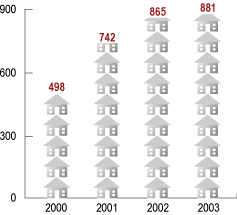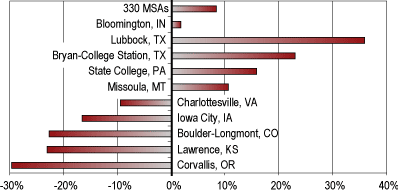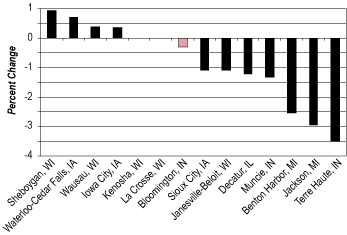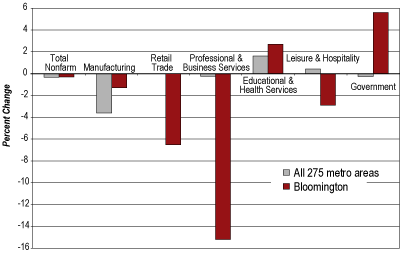Bloomington
Indiana Business Research Center, Kelley School of Business, Indiana University, Bloomington, Indianapolis, and Gary
A booming housing construction market continues to characterize the Bloomington economy. Year-to-date estimates from the U.S. Census Bureau indicate continuing growth (see Figure 1). Added to recent commercial and retail construction throughout the community, Monroe County has been well satisfied with its recent economic performance.
Figure 1
Estimated Housing Units Authorized in Monroe County,
September Year-to-Date

However, in the context of the U.S. economy and in comparison to other college communities, Bloomington does not have the same luster. Figure 2 shows that the Bloomington metropolitan area (Monroe County) had a 1.8 percent increase in housing units authorized compared to an 8.5 percent increase in the nation’s other metro areas. Among the 330 metro areas for which we have data, Bloomington ranked 199th. Although several college communities rank lower than Bloomington, there are also others outperforming Bloomington by substantial rates, notably one that is fixed in our thoughts: Lubbock, Texas.
Figure 2
Percent Change in Residential Units Authorized,
September 2002 to September 2003*

Despite this continuing addition to the housing stock of the community, many argue that the Bloomington area does not offer sufficient affordable housing. Because of Indiana University, a sizable portion of the demand for housing in Bloomington is not only rented but purchased with funds from outside the area. As parents become more able to subsidize their children’s housing, as tax laws encourage ownership of housing by the affluent, and as student loans increase the amount of funding available for students, young people are able to crowd out less-affluent resident families in the area. Although this may seem inequitable, it may not be bad for Bloomington if suitable housing is available in nearby communities.
Employment
Bloomington falls into an interesting group of Midwestern metro areas, all between 54,000 and 76,000 jobs. Included here are other places that have significant college populations (Iowa City, Terre Haute, and Muncie), as well as places better known for their industrial muscle (Decatur, Waterloo, and Kenosha). Figure 3 reports the percent changes in employment these metro areas have experienced in the past year. Bloomington sits in the middle of this group and ranks 143rd out of 275 metro areas nationwide. (Lubbock ranked 99th.)
Figure 3
Percent Change in Total Nonfarm Employment for Selected Midwestern Metro Areas,
September 2002 to September 2003

Figure 4 indicates the percent losses and gains made in Bloomington and the U.S. over the past year. Clearly, professional and businesses services were hardest hit in Bloomington, while the greatest gains were posted by the government sector. The deep decline in retail trade is perhaps some cause for concern since it was not consistent with the national picture and retail is one of the more important sectors of the Bloomington economy.
Figure 4
Percent Change in Jobs in Selected Sectors, September 2002 to September 2003

Average Weekly Wages
Bloomington ranked tenth in average weekly wages among Indiana’s twelve metro areas for the first quarter of 2003 (the latest available data from the Department of Workforce Development). However, it did enjoy the second highest annual growth rate (4.6 percent) behind Gary. Anyone looking to understand why State Road 37 carries so many cars daily to Indianapolis need only look at the fact that the average weekly wage in the state’s capital city is 27 percent higher than in Bloomington. That $150 a week is a substantial differential. Even if it means ten extra hours of commuting, the return is $15 per hour.
Prospects for 2004
The fundamentals of the Bloomington economy are unchanged and participation in the generally favorable economic scenario is likely. But a new administration in City Hall always raises interesting prospects for the community. Will something positive, at long last, be done to reduce traffic congestion on Tenth Street? Will the PCB problem that has hung over the area for more than a generation be attacked vigorously? Will the bipolar disorder of the City Council be resolved so that growth and no growth disputes will no longer make Bloomington one of the state’s persistent jokes?
There are many opportunities for improvement in Bloomington that rest solely with the people of the community.
Also in this Issue…
- Outlook for 2004
- The U.S. Economy
- The International Economy
- Financial Forecast
- Corporate Governance and Reporting
- Housing
- Indiana
- Anderson
- Bloomington
- Columbus
- Evansville
- Fort Wayne
- Gary
- Indianapolis
- Kokomo
- Lafayette
- Muncie
- New Albany
- Richmond
- South Bend/Mishawaka and Elkhart/Goshen
- Terre Haute
- Outlook Summary for 2004



